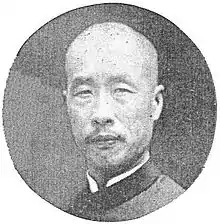Han Fuju
Han Fuju or Han Fu-chü (simplified Chinese: 韩复榘; traditional Chinese: 韓復榘; pinyin: Hán Fùjǔ; Wade–Giles: Han Fu-chü; 1890 – 24 January 1938) was a Kuomintang general in the early 20th century. He rose up the ranks of the Guominjun clique in the Warlord era but then went over to the Kuomintang, and held the position of military governor of Shandong from 1930 to 1938. Han had one wife, two concubines, and four sons.

Biography
Han Fuju was born in Dongshantai Village (Chinese: 东山台村; pinyin: Dōngshāntái Cūn), Ba County, Hebei Province. He had had little aptitude for schooling. Nonetheless, while quite young, he had worked as a clerk in his hsien ("county") until his gambling debts forced him to run away and enlist in the army of General Feng Yu-hsiang. Han rose quickly, from clerk to chief clerk, to lieutenant, to captain, and after an uprising, to major. During the warlord upheavals of the 1920s he emerged as commander of General Feng's 1st Army Group.
Governor
In 1928 he was appointed chairman (governor) of Henan province by Feng, and in 1929 he was confirmed in office and concurrently named commanding general of the 11th Division. When the Christian general revolted later in the year, Han declared his allegiance to the central government of Chiang Kai-shek. In the Central Plains War in 1930, Han fought against the rebel troops of Yen Hsi-shan and his former commander Feng Yu-hsiang in Shandong and was rewarded with appointment as governor of that province.[1]
Warlord

He took over Zhang Zongchang's role as the warlord in Shandong Province. In autumn 1932, unified the province after defeating the rival warlord Liu Zhennian, who controlled the eastern part of the province (in particular the sea port of Yantai) and was known as the "King of Eastern Shandong ". As governor, Han was a stern disciplinarian with civil servants and the military. He had virtually wiped out banditry and traffic in narcotics in campaigns of suppression. Through commercial operations, principally in cotton, tobacco, and real estate, he grew rich and gave generously to schools, hospitals, and civic improvements.[2]
In the mid-1930s he was the target of Japanese attempts to get him to incorporate his province of Shandong into one of the North China puppet states they were attempting to construct. After the onset of the Second Sino-Japanese War, he commanded the 3rd Army Group and in 1937 was made Deputy Commander in Chief of the 5th War Area defending the lower Yellow River valley. Han was suspected of having conducted secret negotiations with the Japanese to spare his province and his position of power. When the Japanese crossed the Yellow River he abandoned his base in Jinan. Han abandoned his army on January 6 and fled to Kaifeng, where he was arrested on 11th and brought to Wuchang and was later executed by Chiang Kai-shek for disobeying orders from superior commanders and retreating on his own accord.[3]
Chiang did this to set an example for those not following his orders. According to one account, Han Fuju was executed in the sanctuary of the Changchun Temple (长春观), a Taoist temple at the outskirts of Wuchang (now, almost in the center of modern Wuhan) by a single pistol bullet fired into the back of his head by Chiang Kai-Shek's chief of staff, General Hu Zongnan.[4][5] There are only second-hand accounts of the execution.[6]
Career
- 1928 - 1930 Chairman of the Government of Henan Province
- 1930 - 1938 Governor of Shandong
- 1937 General Officer Commanding 3rd Route Army
- 1937 - 1938 Commander in Chief 3rd Army Group
- 1938 Deputy Commander in Chief 5th War Area
- 1938 Arrested and executed at a military conference in Hankou for failing to defend Shandong
Personal life
Besides for his execution as a traitor, Han Fuju is remembered for his bad jokes and poetry.[7] According to Historian Diana Lary, one of his best known poems was about the Daming Lake in Jinan,[6] though the same poem has also been attributed to Zhang Zongchang by newspapers such as the Beijing Evening News and People's Daily.[8]
Sources
- Frank Dorn, The Sino-Japanese War, 1937-41: From Marco Polo Bridge to Pearl Harbor (New York: Macmillan, 1974), pg. 81-82
- Dorn, pg. 81-82
- Dorn, pg. 82
- MacKinnon, Stephen R.; Capa, Robert (2008). Wuhan, 1938: War, Refugees, and the Making of Modern China. University of California Press. p. 18. ISBN 978-0-520-25445-9.
- Stephen MacKinnon, "The Tragedy of Wuhan, 1938", Modern Asian Studies, Vol. 30, No. 4, Special Issue: War in Modern China (October , 1996), pp. 931-943
- Diana Lary, "Treachery, Disgrace and Death: Han Fuju and China's Resistance to Japan", War in History, 2006
- Diana Lary, "China's Republic", Cambridge University Press, 2007
- Guang Zijian; Wang Xing (3 February 2016). "古代奇葩"诗人":乾隆酷爱卖弄 张宗昌粗话连篇" [Ancient wonderful "poet": Qianlong loves to show off Zhang Zongchang's swearing]. Beijing Evening News, People's Daily. Retrieved 2 February 2019.